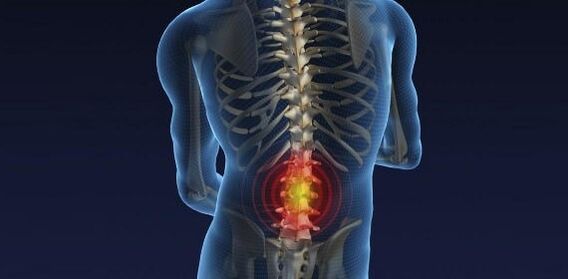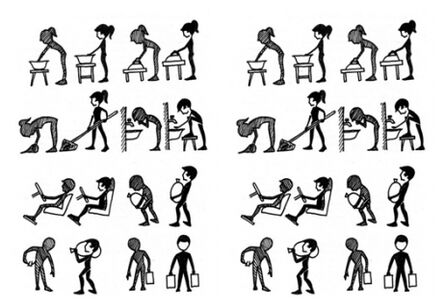
Back pain and limbs are one of the most common disorders.It is the second most frequent cause of medical treatment after respiratory diseases.About half of people in working age during their lives bears episodes of back pain and prolonged disability.
What is osteochondrosis
Osteocondrosis is a disease in which the degeneration of the intervertebral disc occurs.
The intervertebral disc consists of a fibrous ring (concentric layers of strong connective tissue fibers) and a nucleus of the jacket in the center.The quota of the discs represents about a quarter of the length of the spine, they play the role of the shock absorbers - with a vertical position, curves, inclinations and extension of the spine, the nucleus and the fibrous river of the disc, takes the axial load stop, occupies the initial position.A significant load falls on the discs of the lumbar and cervical column, since these departments have maximum mobility.This explains the fact of the greatest gravity of the degenerative changes in the cervical and lumbar column.
One of the causes of discs degeneration is their insufficient nutrition, which, in turn, is a consequence of a person's weak physical activity.
The water content and the elastic properties of the disc are also significantly reduced with age.The fibrous ring of the disc loses its elasticity, the cracks appear in it, in which, at each new load, the nucleus of the jacket begins to be introduced more and more, moving on the edge of the disc, with the full breakage of the fiber ring, the content of the nucleus goes beyond its limits - there is an hernia of the nucleus of the jacket.More often, a lateral displacement of the disc occurs in the direction of the intervertebral hole through which the spinal cord spinal spine passes.In this regard, the most frequent event of an hernia is to squeeze the corresponding root and the development of a characteristic pain syndrome.Under the influence of the impulses from the receptors of the interested segment, the muscles of the spine of spine intertwine reflectedly
Risk factors for osteochondrosis
Currently, the risk factors for the occurrence of manifestations of the pain of the osteocondrosis include:
- Hereditary weakness or congenital defects of the spine;
- spinal lesions that lead to structural changes;
- heavy and unbalanced physical activity;
- For a long time staying in a forced pose with distortion and shift;
- Hypodynamia, inactivity, monotonous work.
The factors that contribute to the occurrence of osteochondosis and its exacerbations may be various infectious diseases, cooling, overwork, power disorders, including a lack of vitamins, obesity, factors and environmental habits, endocrine disorders, etc.
What to do if the back is sick
Pain is a warning sign and protects from damage to the effects within the body.First of all, the pain occurs when it moves, changing the posture and passes to rest, as the disease advances, the morning rigidity appears, which can last 30-60 minutes.The duration of the disease can be several weeks or months.
What to do if the back hurts?Make sure to consult a doctor during the first 3-5 days (to avoid running the disease).Use simple suggestions, in addition to the doctor's recommendation:
- The overload should be avoided.To avoid problems, try to constantly monitor the correct position of the body.The excess weight increases the load on the spine.Not all sports are the same profits.It is better to avoid play sports and jump and choose excursions, skis and swimming: they will only benefit the spine.

- Organize sleep, food and rest correctly.For the maximum effect, choose a fairly hard mattress and a orthopedic cushion will be the best choice.
- Organize your job correctly.The chair with a low seat, inclined towards the rear, which should be convex in the place of the lumbar column (or it is recommended to lay a roller), it will be ideal.
- Position treatment.With a fairly high roller installed under the lower lumbar lordosis, the "theses" muscles relax, the pressure on the rear parts of the damaged discs of the lumbar column decreases, the pain decreases.After a working day, it is advisable to spend 30-60 minutes in this position at home before bedtime.
- Therapeutic gymnastics (exercise therapy).Gymnastics constitutes a strong muscle corset around the spine, dedicates 15-25 minutes every day (it is possible for 2-3 approaches).The set of exercises should be prescribed by the attending physician depending on the intensity of the pain, at the end of the article we will give the most common complexes of therapeutic exercises depending on the period of the disease (acute phase, remission, etc.)
Recommendations on motor mode in the acute period
In the acute periodIn the presence of acute pain, a rigorous bed rest should be observed.LFK is mainly used with hygienic purpose and is of a general strengthening in nature.Exercises that cause pain should be limited in breadth, degree of muscle tension or excluded.It is very important not to engage in pain and do everything very slowly, repeating every exercise 8-10 times.
When moving the lower limbs, prevent an increase in lumbar lordosis (bend the spine forward), which can improve pain syndrome.In the second phase of the acute period, with a decrease in pain intensity, it is necessary to carefully include isometric exercises to train the abdominal muscles and great buttocks.
With a decrease in pain syndromeThe chances of using special and development exercises increase.In this period, in addition to the exercises that increase the strength of the abdominal muscles and hip muscles, the exercises are important, with folding of the lumbar column.
When choosing both special and development exercises, it is important to make sure that lumbar lordosis does not increase.Pain is a signal for a change in the structure of the exercise (towards relief) or to exclude it.At the end of the second period, it is necessary to gradually include exercises that increase the strength of the back muscles, they can be performed in a circular system 2-3 times.They are the most important.Take the number of repetitions of special exercises 15-50 times.The rhythm of the exercise can be gradually increased.
In the period of remissionExercises are added to increase the mobility of the spinal column.However, the exercises aimed at solving this problem should be performed with care and in light light positions.Automatism should be obtained from the maintenance of a specific posture in the erect position and in walking, when the lumbar column is bent.The reduction of the repetitions of special exercises of the second period increases 50-100 times (it can be broken during the day).The use of training therapy in the pool is recommended for the period of the period, but gymnastics in the pool does not replace, but integrates the main "dry" classes.
Other means of operating therapy, it is recommended to use those that will not influence the negative ways on damaged discs: swimming, earthly, skiing, running route, ergometer by bicycle, exercises with an elastic.Apply vehicles such as volleyball, tennis (large and small), road bicycle, cross -coss -country race, fast dance, rhythmic gymnastics should do extremely careful, because sudden and curved movements can cause an exacerbation of osteochondosis.The handbrake exercises are preferably performed in the lying position (on the back, abdomen) to exclude vertical loads on the spine.
The exercises that they use pure hanged due to the strong tension of the elongated muscles of the body, jumping into the depths of the elevation, exercises on the car and launch machine are undesirable.In any case, during the exercise therapy, it should be remembered that the constant injury and overload of the spine, the shocks along the axis of the spine prepare the appropriate background for the breaking of the damaged disc and the exacerbation of pain syndrome.
























